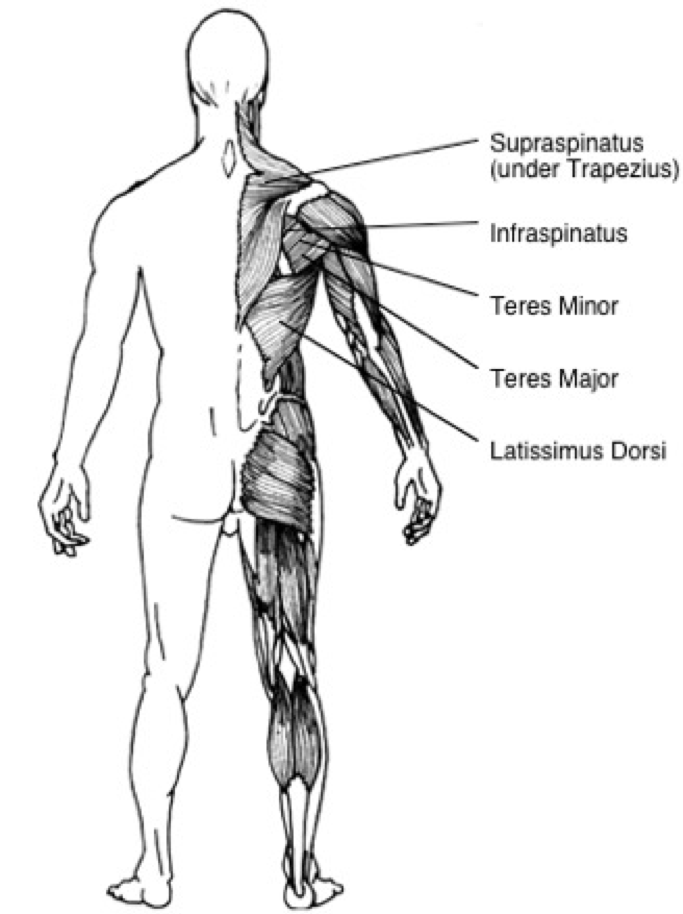By Dr Paul Batman, PhD.
MUSCLE: TERES MINOR and INFRASPINATUS
DESCRIPTION:
The teres minor is strongly linked with the infraspinatus and is located on the posterior aspect of the scapula. Both these muscles work together to produce the same actions at the shoulder joint.
ORIGIN:
Infraspinous fossa and lateral border of the scapula.
INSERTION:
Lateral posterior surface of the greater tubercle and capsule of the shoulder joint.
MUSCLE GROUPS:
The teres minor and the infraspinatus belong to the following muscle groups:
Shoulder joint horizontal abductors, shoulder joint lateral rotators, shoulder joint extensors (helping).
STRENGTHENING EXERCISES:
One arm dumbbell row (pronated), reverse pec deck, bent over barbell row, seated row (pronated), bent over inverted flye.
CASE STUDY STRENGTHENING EXERCISE: BENT OVER BARBELL ROW (pronated grip).
- Position yourself directly behind a barbell placed on the ground. Place your feet firmly on the ground, slightly wider than shoulder width apart.
- With your knees slightly bent and your back straight, bend forward at your hips and grasp the barbell with a pronated grip wider than shoulder width apart
- Contract your abdominals and back muscles throughout the exercise to support the horizontal straight back position
- From this starting position, pull the bar up towards your chest by bending your elbows. Continue until your elbows are raised as high as possible and the bar contacts your chest
- Keep your elbows out to the side so that your arms move in a plane 90 degrees to your trunk
- Pause and then slowly lower the bar back to the starting position
STRETCHING EXERCISES:
Lovers combo, pec dec stretch (in front of body), lat and triceps stretch.
CASE STUDY STRETCHING EXERCISE: PEC DEC STRETCH.
- Stand in an upright position with your right arm held to the side of your body at shoulder height
- Move your right arm with your elbow straight, directly across your chest
- Grasp your right elbow with your left hand and continue moving your right arm across your chest until you feel a comfortable stretch at the back of your shoulder
- Hold the stretch for approximately 20 seconds and then return your right arm back to the starting position
- Repeat the stretch on your left arm
PALPATION:
With a subject lying face down on a bench have one arm hanging over the side. Palpate the lateral border of the scapula as the subject horizontally abducts against resistance. The infraspinatus can be palpated as a large muscle directly across the infraspinous fossa on the scapula, immediately below the posterior deltoid. The teres minor is immediately below it.
TRAINERS TIPS:
- The teres minor and the infraspinatus are part of the rotator cuff group responsible for shoulder joint stability. The infraspinatus and teres minor pull the humeral head into the shoulder joint while the coracobrachialis, deltoid and triceps pull the head up.
- The rotator cuff muscle group which also includes subscapularis and supraspinatus, hold the humeral head into the glenoid fossa preventing it from dislocating when the shoulder joint is abducting and laterally rotating.
- Powerful movements of the shoulder joint can tear the rotator cuff muscles due to the eccentric braking in medial rotation and horizontal adduction.
- The teres minor and infraspinatus also work with the subscapularis as they depress the humeral head and prevent it from jamming up against the acromion during shoulder joint flexion and abduction.
- For the teres minor and infraspinatus to work effectively the scapula must move at the same time as the shoulder joint does in horizontal abduction. This is an example of dynamic stability.
- Different grips in an exercise can change the involvement of the teres minor and infraspinatus. Pronated grips tend to accentuate their involvement, while supinated and neutral grips lessen their impact. This can be readily seen in seated row exercises. The seated row (neutral grip) accentuates the involvement of the pectoralis major and the latissimus dorsi and the teres major. In the seated row (pronated grip) the teres minor and the infraspinatus are now the target muscles.
- The teres minor and the infraspinatus are target muscles for lateral rotation exercises. This can be seen in cable pulley shoulder rotating exercises.
